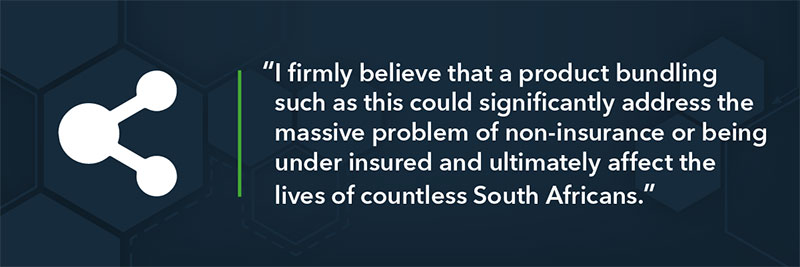
What’s the problem?
As few as 19% of South Africans have an insurance product of any kind. The only insurance category with a relatively high take-up rate is funeral cover, with estimations of around 40% of South Africans having some form of funeral cover in place. At the other end of scale, it’s estimated that only 10% have life insurance or physical asset insurance, 8% have traditional health insurance and as few as 30% of motorists have car insurance. What is even more alarming is that these percentages may actually be shrinking.
Why?
There are two main reasons why so many people are uninsured: education or knowledge, and financial constraints.
When it comes to insurance, South Africans are largely in the dark about the risks that are covered, the benefits offered, the value and the cost. We also tend to mistrust insurance: a common perception is that the insurance companies take money from your account every month and you get nothing in return. Then when it comes time to claim, the insurance company is nowhere to be found. Even though this isn’t generally true, it is a common perception.
Financially, the reason is far simpler: people who already battle to stretch their money simply can’t afford the luxury of insurance, and insurance definitely is seen as a luxury. Insurance is viewed by most as a grudge payment and is one of the first things given up in times of financial difficulty.
The effect:
People who actually need insurance the most are the least likely to have it. Most households in South Africa live hand-to-mouth, often with a single breadwinner – if something were to happen to them and there was no cover in place, the household and family would be under enormous financial pressure to the extent that homes are lost or a child’s education is affected or even ended.
Short-term cover is similar – the vast majority of South Africans will not be in a position to replace a motor vehicle, cellphone or other valuable physical assets if something happens to their valuables, and unfortunately it’s this majority that make up the bulk of the uninsured population.
What can be done?
The problem of underinsurance and no insurance that we are passionate about – we have spent years looking at ways the twin problems of knowledge/trust and affordability can be addressed.
Education and knowledge can be addressed, but it’s a long-term game that won’t help most underinsured people now. The issue of mistrust of insurance companies, though, can be addressed now by offering a tangible benefit of monthly payments. Because they can see that they are getting something for their money, customers are more likely to keep making their payments and so will be covered when they need to be. When they make a successful claim, they will see the true value of cover and will begin to both understand how cover works and trust the company that provides it.
Affordability can be addressed, but not necessarily in the obvious way of making monthly payments cheaper. Instead, value needs to be increased to the point where the cost of the cover is offset by the value the client receives.
Providers need to provide a value solution, but do this in non-traditional ways. How? With paired or bundled products.
An example of such a product could be: if a consumer is already spending R150 on a tangible consumer or service product every month, the provider could offer them a bundled product for R150 containing the same consumer or service product with added protection of an insurance offering. The consumer is getting what we consider to be an essential product in addition to a product they are already buying, and it is not costing them any more money. It’s important to state that each of the underlying products in such a bundle would carry its own cost, which costs are known to the client upfront, and collectively makes up the bundle product price. The value in such an offering is that the end consumer would not be able to purchase either of the bundled products at the price which is offered via the bundle, which is how essential protection and economic value are created.
This would be the most practical and effective way to positively influence a market where paying for an intangible product is mistrusted or considered a luxury. By using a bundle of tangible and intangible products, the perceived value of the cover would increase. Over time, perception will change and by changing perception, we are able to change the purchase behaviour of essential insurance cover from a grudge purchase to a purchase that offers consumer value as well as the value of cover for no additional monthly spend.
I firmly believe that a product bundling such as this could significantly address the massive problem of non-insurance, or being under insured, and ultimately affect the lives of countless South Africans. The knock-on effects of this are potentially immense, in terms of improving consumer education, household stability and even wealth creation.
Kobus Botha is Executive Head: Commercial and Operations for Ignition Financial Services.


